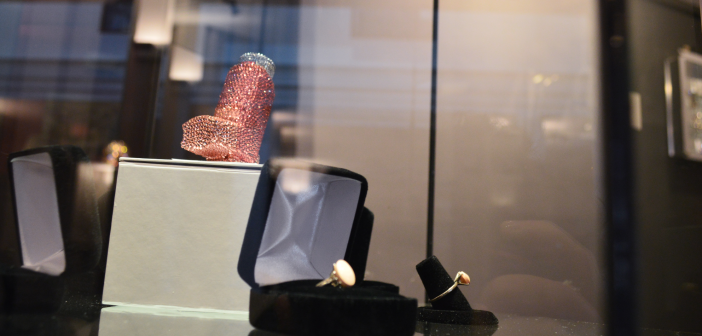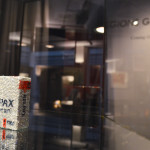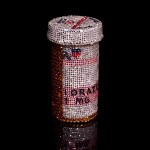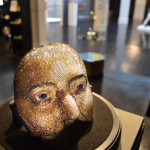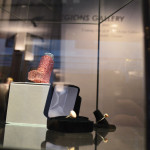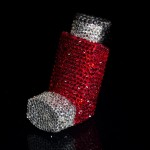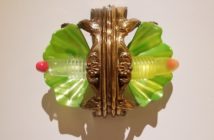Pills are talismans. They are tiny, portable and therapeutic, secular-but-sorcerous objects whose enchantments are swiftly and secretly invoked. Psychoanalyst Ernest Becker wrote, “Pills and pellets are forms of fetishes, ways of overcoming anxiety, the terror of the body, in a reassuring magical way.” That’s not entirely untrue, but it rings a slightly accusatory tone. Similar sentiment is common today amongst otherwise educated First Worlders, who have moved from blind faith in biomedicine to cult-like appreciation of homeopathic gurus.
Somerville-based artist Judith Klausner has a more forgiving view of pill-popping, an attitude required by her several, chronic, medical conditions. In Coming Out of the Medicine Cabinet at New Bedford Art Museum, on view through November 1, Klausner opens her well-stocked personal pharmacy to the public. She’s outfitted the ubiquitous orange of pill bottles with Swarovski crystals, added a few props (nail clippers, a comb) and hung the display “at medicine cabinet height, so you can see yourself in the back of it.”
The artist was motivated by the contradiction pills embody: they are valuable commodities stored and taken in private. “We’re supposed to hide them even though they’re one of the major expenses we have,” Klausner says. “We flaunt things that cost a lot of money, except for these things that are taking care of us.”
Klausner’s collection is relatively tame; don’t expect Desoxyn or oxycodone. Instead, there are inhalers (Advair, Flovent, Albuterol), a tranquilizer (Lorazepam), an antidepressant (Citalopram) and an anti-migraine drug, Relpax. The blister pack of Relpax is particularly striking, its gleaming nodes nearly vibratory in pattern. Though Swarovski rhinestones are not always a wise visual choice, their loudness works here, emphasizing the formal delights hidden in drug packaging. Citalopram looks more uplifting than the actual drug, its pink label sparkly and cheerful. The inhalers are unexpectedly luxurious, perhaps proving Klausner’s point that we typically forget the value (monetary, aesthetic and medicinal) of these drugs.
Structurally, the exhibit recalls work like Damien Hirst’s Pharmacy (1992), a replica of a drug store that offered a typically macho comment by Hirst on the eventual “collapse of a civilization.” Klausner’s pharmacopoeia is smaller and intimate, more personal in tone, as evidenced by the inclusion of Migraine Mask. Cast from her face, the crystal-studded mask is equipped with a burst of metal spikes, its placement mimicking the pain and location of Klausner’s migraines.
Coming Out elegantly builds on Klausner’s past work. Small things fascinate her, and she’s apt at revealing the aesthetic value of the banal, having previously worked with insect wings, toenail clippings, toast, gummy candy and Oreos. Where old keratin and bugs elicit visceral disgust, pills can be reviled in a cultural context.
“There’s this weird sense that somehow you’re not being self reliant enough if taking care of yourself involves other chemicals or other people,” Klausner says. She’s interested in a particularly resilient strain of sloppy thinking, that which entwines self-care and health with “personal responsibility.” She points out the uncouth way in which people compare medicines to “crutches,” and offers a shrewd rejoinder: “Would you take a crutch away from someone with a broken limb?”
Pill poppers (especially those throwing back psychotropic drugs) are doubly cursed: admitting illness is a venial sin, soothing it through artificial means a cardinal one. The healthy person’s experience of illness as a temporary trouble might encourage these pervasive and misguided feelings. Klausner finds that people who don’t have a chronic illness can “experience [illness as something]that starts and ends.” She refers to her chronic conditions as invisible disabilities, ailments no less painful or exhausting than visible ones.
Illness, wrote Susan Sontag, is “a more onerous citizenship.” It plagues both the physical and social body. Klausner expresses some trepidation at the confessional nature of the exhibit: “It’s the most personal thing I ever made, which is terrifying . . . My parents were a little concerned about it. I’ve opened my medicine cabinet and put it on the internet with my name [attached.]” In a work culture where “a lot of places are going to not want to hire someone with a medical condition,” Klausner says, admitting to the medicated life can be a political act.
One can celebrate the medicinal and still denounce the vulturous market of pharmaceuticals. Klausner needed to acknowledge that the cost of these medicines destroys any romantic ideas we might hold. That the body relies on money for sustenance is a brutal truth of modern capitalism. The rhinestones are a straightforward but effective illustration of this conflict. Once, when “health insurance had decided I had enough migraines for the year,” Klausner says she was charged $50 for a single Relpax. The exorbitant pricing led her to a new place of inquiry. “I bet I could get a good size garnet for the same price as this pill,” Klausner thought.
There was the genesis for the articulate and inquisitive Coming Out. Speaking as someone who also has a chronic, unseeable disease kept in check by powerful (and powerfully expensive) medicine, I deeply admire Klausner’s approach to this topic. Swarovski crystals would be an obnoxious medium (Hirstian in their own right) were it not for the crucial issues they interpret here. “I wanted to make them as unhidden as possible: bright, glittering, meant to be seen,” Klausner says.
She certainly succeeds. It’s hard to miss the distinctive twinkle of a glut of rhinestones. It would be a mistake, however, to call this exhibit ‘unafraid’ or ‘bold.’ On the contrary, Klausner’s bejeweled medicines are trembling and shining, vulnerable but armored. They vibrantly animate the daily struggles of chronic illness, both the sickness itself and the unfortunate stigmas that surround medication use.
Klausner understands medication as a primary means of self-care. “We’re really into taking care of ourselves if it involves exercise,” she says, but other methods invite criticism. This aversive attitude to biomedicine is ironically concentrated where such treatments are readily available. As anthropologists Susan Reynolds Whyte et al. note in Social Lives of Medicines, lax prescription drug regulations in impoverished Asian countries inspire self-medication with pills. Behaviors which might be viewed as weak or unwise in the US (or, even worse, by patronizing academics as “false consciousness”) can be self-preserving elsewhere. “If life is uncertain and dangerous, there is security in these little but powerful objects,” write the authors.
Klausner recognizes this, placing her faith in tiny chemicals to keep well. It’s a rewarding belief, one that allows Klausner “to hold a day job and a social life.” Still, there’s a persistent social delusion that using a drug to achieve health is ‘faking it.’ A market ruled by blockbuster proprietary drugs means that, authentic or not, feeling good will cost you. In resistance to these forces, Klausner opens her medicine cabinet, widening our concept of strength and self-care.
- Installation shot of Judith Klausner’s Relpax
- Judith Klausner Lorazepam 2.75×1.5×1.5″, prescription pill bottle, Swarovski crystals, 2014
- Installation shot of Judith Klausner’s Migrane Mask
- Installation shot of Judith Klausner’s Flovent Inhaler
- Judith Klausner Red Albuterol Inhaler, 2.5×1.25×1.75″, albuterol inhaler, Swarovski crystals, 2013
- Judith Klausner Advair Diskus (inhaler) 3.5×3.5×1.25″, inhaler, Swarovski crystals, 2014
"Coming Out of the Medicine Cabinet" is on view through Sunday, November 1 at the New Bedford Art Museum.

